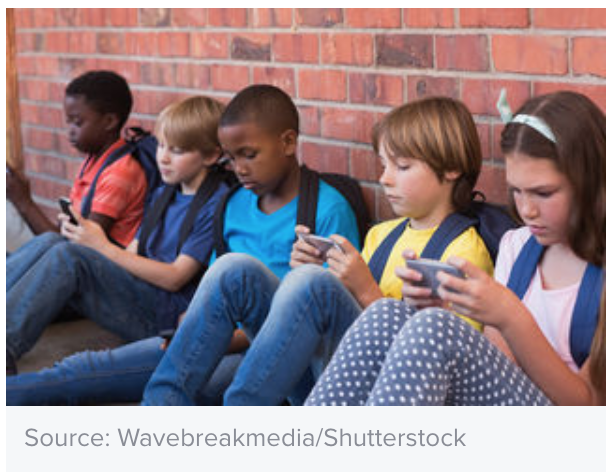Very informative article below but the thought that the American Psychological Association is going to step up and do the right thing by our children is almost laughable. After all, the APA has a long history of participating in mind control, with past presidents like Ewen Cameron, who was the head torturer for the MK Ultra Mind Control project (see here, here, and here). As far back as the 1950s (perhaps earlier), members of the APA were already engaged in using electroshock torture to try to wipe the memories of their victims clean. Now, in 2018, they have simply stepped up their electroshock game with the use of manmade radiofrequency and microwave radiation that can blow holes in the blood brain barrier of our children and lead to dementia in people as young as 30.
The APA is also the same organization that has its roots in people like Sigmund Freud who convinced the world that little children are obsessed with their anuses and very much want to have sex with their parents. In 1998, the APA came out in full support of pedophilia, issuing a report claiming “that the ‘negative potential’ of adult sex with children was ‘overstated’ and that ‘the vast majority of both men and women reported no negative sexual effects from childhood sexual abuse experiences.” In 2013, the APA moved to declassify pedophilia as a mental disorder and instead label it a “sexual orientation.” The APA is/was also on the fence about whether to classify hebephilia (an attraction to children in early puberty) as a mental disorder, and hence, in 2014, a conference was held at Cambridge University to discuss the matter. Speakers at the conference affirmed that “paedophilic interest is normal and natural in human males” and “at least a sizeable minority of normal males would like to have sex with children… Normal males are aroused by children.”
Without a doubt, the APA is one of the most vile and disgusting organizations ever to be formed and the fact that we have accorded it even an ounce of respect is an indication of our own mental weakness. Expecting the APA to do the right thing by our children is insane.
Source Article: How the Tech Industry Uses Psychology to Hook Children https://www.psychologytoday.com/us/blog/mental-wealth/201810/how-the-tech-industry-uses-psychology-hook-children
This post is written by Richard Freed, Ph.D., psychologist and author of Wired Child: Reclaiming Childhood in a Digital Age, and Meghan Owenz, Ph.D., assistant teaching professor at Penn State University and founder of ScreenFreeParenting.com.
Why do kids struggle to look up from devices? The answer is persuasive design.
“Something’s wrong with my son. He won’t spend time with us, won’t do his homework… all he wants to do is be in his room and play his game.”
Parents, educators, and health professionals around the world are expressing frustration and alarm that children are being lost to video games, social media, and phones. What’s vital to understand is that children’s fixation with gadgets and entertainment applications is by design. Actually, a relatively new concept called persuasive design.
Persuasive design has been in the news a lot recently. Put simply, persuasive design is the practice of combining psychology and technology to change people’s behavior. Gadgets and applications are developed by psychologists and other user experience (UX) researchers who apply behavioral change techniques to manipulate users. The concept can sound scary, however, these techniques can be used to encourage positive behaviors, such as exercise, healthy eating, and smoking cessation.
Nonetheless, persuasive design is increasingly employed by video game and social media companies to pull users onto their sites and keep them there for as long as possible—as this drives revenue. While persuasive design is applied through technology, the power to alter behavior is primarily derived from psychology. Video game developer and psychologist John Hopson describes how Skinner-box principles are used to increase video game use, comparing players to lab animals: “This is not to say that players are the same as rats, but that there are general rules of learning which apply equally to both.” In his paper “Behavioral Game Design,” Hopson explains how psychology is used to keep players staring at screens, answering questions such as: “How do we make players maintain a high, consistent rate of activity?” and “How to make players play forever.”
Persuasive design works by creating digital environments that users believe fulfill their basic human drives — to be social or obtain goals — better than real-world alternatives. Specific techniques used by psychologists and other UX designers to hook users include the use of variable rewards, as video games and social networks are designed to act like slot machines. “Likes,” friend requests, game rewards, and loot boxes are doled out at just the right time to increase what’s referred to in the industry as “time on device.”
Persuasive Design’s Power Over Children and Teens
Many adults, influenced by persuasive design, are challenged to look away from their phones. However, children and teenagers are far more vulnerable, as their brains are still developing and executive functions—including impulse control—are not well developed. As Ramsay Brown, neuroscientist and co-founder of the artificial intelligence/machine learning company Boundless Mind, says in a recent Time article, “Your kid is not weak-willed because he can’t get off his phone… Your kid’s brain is being engineered to get him to stay on his phone.”
Techniques used by video game and social media companies often exploit children’s developmental vulnerabilities. For example, teens’ highly elevated desire for social acceptance and fear of social rejection is a well-known aspect of their psychological development. Rather than handling this limitation with caution, proponents of behavioral design see it as a gold mine. As psychologist B.J. Fogg, the father of persuasive design and creator of the Stanford University Behavioral Design Lab, says, “Today, with social technologies a reality, the methods for motivating people through social acceptance or social rejection have blossomed.”
Revealing another dark side of persuasive design, Bill Fulton, who trained in cognitive and quantitative psychology, says of video game makers, “If game designers are going to pull a person away from every other voluntary social activity or hobby or pastime, they’re going to have to engage that person at a very deep level in every possible way they can.” And that is a key reason why persuasive design is having such a negative impact on childhood, as digital products are built to be so seductive that they replace real-world activities—many of which kids need to grow up to be happy and successful.
Children’s time on screens and phones has increased exponentially in the past decade, with the typical U.S. teen now spending 6 hours, 40 minutes a day using screens for entertainment. Less advantaged children are even more immersed in screens: lower-income teens spend 8 hours, 7 minutes a day using screens for entertainment, compared to 5 hours, 42 minutes for their higher-income peers; and teens of high-school-educated parents spend 7 hours, 21 minutes each day with entertainment screens compared to 5 hours, 36 minutes for teens of parents with a college degree.
Persuasive Design’s Impact on Children’s Well-being
The technology industry’s use of behavioral psychologists and psychological manipulation tactics is contributing to high levels of stress in families and putting children’s well-being at risk. The American Psychological Association’s (APA’s) most recent Annual Stress in America study found that 48% of parents surveyed said that regulating their child’s screen-time is a “constant battle,” while 58% said their children spend too much time with their devices.
Even teenagers are admitting that screen-based technology is a problem. Fifty percent of U.S. teens report that they feel “addicted” to their devices. And hinting at compulsive or even addictive use, according to the Pew Research Center, over half of teens report that they have tried to cut back on their phone use. And, according to Pew, ninety percent of teens say that spending too much time online is a major problem for their generation.
Quality, peer-reviewed research is also demonstrating the serious negative effects of kids spending long periods of time with screens and phones. Psychologist Jean Twenge’s research reveals that the greater time teen girls spend on social media and smartphones the more likely they are to be depressed and have suicide-related behaviors. Kids’ wired lives are destructive because of their displacement of vital developmental activities, such as engaging with family, but also because screen immersion increases kids’ exposure to problem content, including cyberbullying and the fear of missing out (FOMO).
While girls are especially taken with social media, boys are more likely than girls to overuse video games, a problem associated with lower academic achievement. A recent National Bureau of Economic research study argued that the rise in recreational video game play may explain the decreased labor force participation of young males. Boys and young men are also more prone than their female counterparts to video game addiction, a diagnosis recently recognized by the World Health Organization, which is estimated to affect 8.5% of adolescent male gamers (compared to 4.5% of female adolescent gamers). Such addictions often lead to tragic outcomes for kids and their families.
What is the Psychology Profession Doing About Persuasive Design?
A surprising group has stepped forward to call attention to the harmful effects of persuasive design on children: technology executives. Tristan Harris, formerly a design ethicist at Google and now with the Center for Human Technology, says, “The job of these companies is to hook people, and they do that by hijacking our psychological vulnerabilities.” Likewise, Sean Parker, Facebook’s former president, says that Facebook exploits “vulnerability in human psychology” and remarked, “God only knows what it’s doing to our children’s brains.”
While tech execs are speaking out about the industry’s use of psychological manipulation, the American Psychological Association (APA) has not yet made a statement about psychologists and other UX designers employing psychological techniques that encourage kids’ screen and phone overuse. This is in spite of the APA Ethics Code, which says that psychologists are to do no harm, not engage in subterfuge, and be extra cautious in the treatment of children because of their struggles with “autonomous decision making.”
Moreover, every psychological intervention requires informed consent, e.g., efforts to change behavior through treatment are explained so that consumers can make informed choices about their treatment. This is obviously not happening with persuasive design. No one is informing these children or their parents that the reason kids cannot get off their devices is because the technology is designed that way. The bottom line: Psychologists’ use of persuasive design to influence children and teens is unethical, is hurting a generation of kids and their families, and should be immediately addressed by the APA.
By taking action, the APA has the opportunity to not only address psychologists’ use of persuasive design but also uphold public confidence in the profession. Parents around the world are increasingly angered by their inability to control their children’s destructive overuse of social media, video games, and smartphones. As the spotlight increasingly turns on psychologists’ role in creating digital products that encourage overuse, public confidence in psychologists and the profession will be jeopardized.

